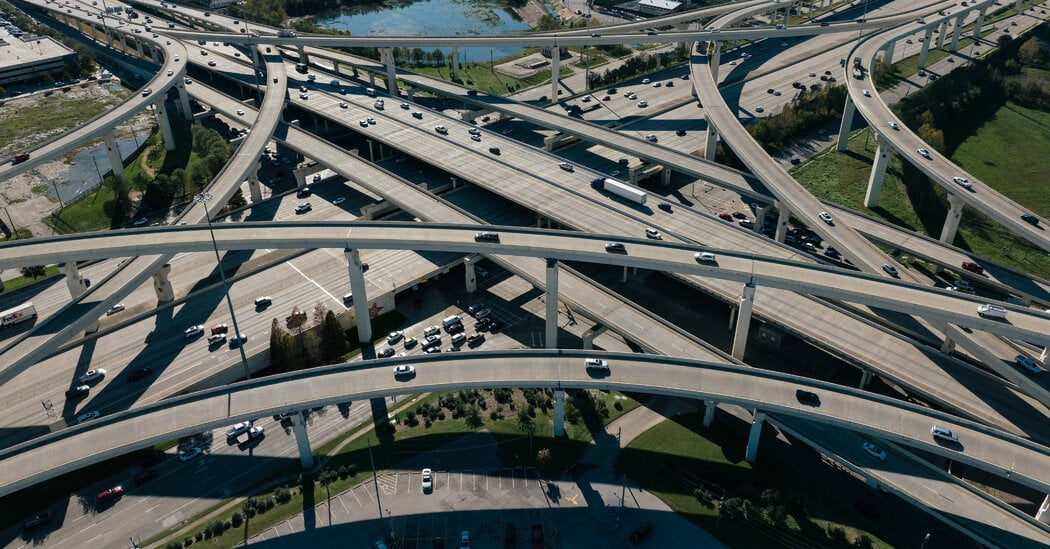For critics of widening projects, the prime example of induced demand is the Katy Freeway in Houston, one of the widest highways in the world with 26 lanes.
Immediately after Katy’s last expansion, in 2008, the project was hailed as a success. But within five years, peak hour travel times on the freeway were longer than before the expansion.
Matt Turner, an economics professor at Brown University and co-author of the 2009 study on congestion, said adding lanes is a fine solution if the goal is to get more cars on the road. But most highway expansion projects, including those in progress in Texas, cite reducing traffic as a primary goal.
“If you keep adding lanes because you want to reduce traffic congestion, you have to be really determined not to learn from history,” Dr. Turner said.



No, I’m sorry, but the reason congestion persists is induced demand. That with a wide open highway, more people use the highway until congestion returns. This means that more people are able to use the highway at the end of the day. Invest in mass transit and walkability, absolutely, but without appropriate transportation infrastructure problems will appear.
Weirdly aggressive way to agree with everything I was trying to say, thanks.
Yeah I mean you’re kind of just re-framing point. Yes the mega highway has the ability to move more cars, but still the end result after 5 years is it’s actually taking longer to move cars than before (at peak travel time). So what if it’s due to induced demand, we just want to solve the problem of getting people from point A to B, and adding more lanes is a very inefficient transportation method. It’s a massive waste of resources when moving around in a car is so costly compared to public transit.
Which is why you do both. There’s lots of reasons people sometimes don’t use public transit. Refusing to modernize highway infrastructure will kill local industry and punish people whose commutes are inevitably not adequately covered by public transit because they fall outside the planning of the planners.
I see better where we disagree now.
I would contend that allowing sprawl to get bad enough that you can even contemplate 26 lanes is the real “refusing to modernize”.
I would contend that while promoting densification is wise, allowing people to live where they want us also wise.
As long as we’re talking about allowing and not “privileging”. When we allow auto industry political interests to sway spending, that’s what usually happens. Moving away from that and toward density is usually fairer than it feels (as equality often does feel unfair to the privileged).
We have a lot to untangle politically and economically. A lot of infrastructure is too utilized for direct profit rather than societal good. Some US states even have privatized DMVs.
I totally agree, and we should be spending on public transit. But going to people and telling them that it is going to be a matter of public policy that they shouldn’t be driving?
Should we instead run society based on “but what will the reactionaries think?”
So now people who don’t want to ride a bus are “reactionaries?”
That’s not what they’re saying. No one’s going to stop you from living in a suburb 50 miles from your job. But the argument is that maybe a city should stop encouraging people to do so by investing their limited resources in mass transit and denser housing, thus giving some people the option of NOT having to live 50 miles away.
And if road infrastructure is neglected, then anything larger than a person can’t easily move in or out of the city. So, you need to invest in both. Buses, freeways, and in a very urban area, rail.
What does modernizing highway infrastructure even mean? I don’t think you could call adding more lanes “modernizing” if you’re being serious. That’s been the blind answer for years but adding more lanes does not solve congestion/demand/whatever you want to call it. It’s not an efficient way to solve the transportation problem. You spend a ton of resources (punishing people bulldozing neighborhoods or with noise pollution, destroying nature, etc) and you still have the same ultimate problem you did before you started, people traveling slowly in a pollution emitting vehicle. So doing both is not even the point when one side of the equation (adding lanes) is a very poor solution. Focus on better solutions like public transportation reaching more people.
deleted by creator